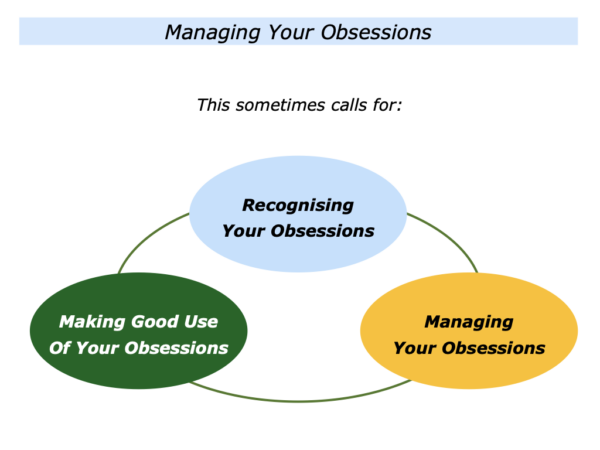
Great workers are often obsessed by doing certain things. They may feel compelled to encourage people, play the piano, climb mountains, solve certain kinds of problems or do other activities.
Such workers often have a different kind of OCD in the areas where they excel. They have obsessive compulsive discipline. They like to feel in control and follow certain disciplines to do great work.
Imagine that you have some obsessions that you want to channel in a positive way. One approach is to recognise, manage and make good use of the obsessions. Let’s explore these themes.
Recognising Your Obsessions
What are your obsessions? What do you keep thinking about? What are the things you find fascinating? What are the things that you cannot help but do? What do you feel compelled to focus on?
People who do creative work often follow certain obsessions. They may be obsessed by designing gardens, solving maths problems, finding medical cures, renovating houses or doing other activities. They then follow certain routines to translate these into action.
Such people like to feel in control. They may do this by being obsessive about following certain habits in their daily lives. They like to follow consistent patterns and make things as predictable as possible.
Some people have obsessions they channel in a positive way. Some may have obsessions that create challenges. This leads to the next theme.
Managing Your Obsessions
Imagine that you have recognised some of your obsessions. How can you manage these in a positive way? People sometimes need to go through the following stages to make this happen. They need:
To manage their obsessions rather than let their obsessions manage them;
To recognise the potential pluses and minuses of their obsessions – both for themselves and other people;
To find ways to build on the pluses and minimise the minuses of their obsessions.
Great workers often follow their chosen strategies for managing their obsessions. Some do this in a structured and systematic way that enables them to focus. Such an approach can have both pluses and minuses.
The pluses may be:
They stay ahead of the game … They are fully prepared … They know some areas in great detail … They get things done effectively … They follow a predictable rhythm … They anticipate future scenarios … They perform superb work and get a sense of satisfaction.
The potential minuses may be:
They may appear anti-social when doing their work … They may appear odd … They may behave in ways that affects others … They may have blind spots.
A person with a creative drive, for example, may learn to manage these pluses and minuses. One approach is to organise their days so that: a) they can give quality time to their loved ones; b) they can spend quality time pursuing their obsession.
Different people build on the pluses and manage the minuses in different ways. Let’s look at one example.
Eric had an engineering background and was driven to make things work properly. This had both pluses and minuses. He expressed these n the following way.
“I strive for perfection. Whilst this is a great driver, it also has a downside. I love to make things work properly, but I also spend a lot of time worrying.
“How can I stop worrying? Sometimes I worry so much that I begin to feel negative. This can affect both me and other people.”
Eric and I explored how he could build on the pluses of his approach. His drive for perfection was a great motivator. He focused on things he was passionate about, prepared properly and absorbed himself in his chosen projects.
The people Eric worked with – his company, colleagues and customers – saw him as an expert. They respected his drive and desire to constantly improve.
Eric could build on these qualities, but he also needed to find ways to manage his worrying. Bearing this in mind, we focused on how he could balance being a warrior and a worrier.
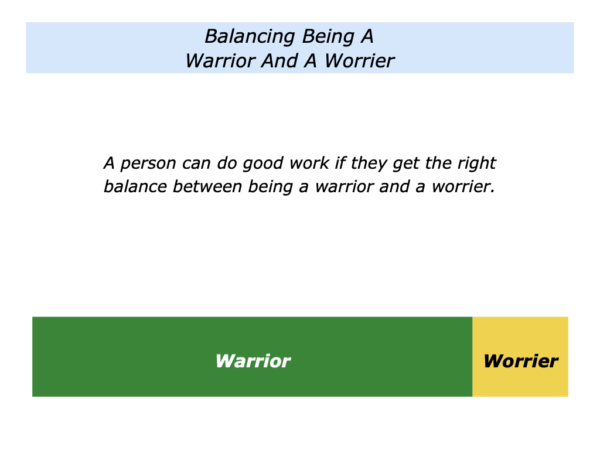
Great workers get the right balance between being warriors and worriers. Being sensitive to issues, they use worry as a drive to fix problems, improve things or work towards achieving perfection. Sometimes the balance can get out of kilter, however, and can cause problems.
As mentioned earlier, however, the key is to get the right balance. If you are a warrior to 90% and a worrier to 10%, you may channel these feelings in a positive way. If you worry to a greater extent, you may seize up and not do anything.
Eric and I explored ways that he could accept his personality. He would always be a perfectionist. But it was also important to accept that sometimes perfection was not possible.
We therefore focused on: a) the specific activities where he could pursue his drive for perfection; b) the specific activities where perfection may not be possible.
He wanted to feel in control. We therefore explored how he could feel in control in each of these activities. Sometimes this involved accepting that he had done his best but some things were beyond his control.
Eric began to pursue this approach and, even though it was hard at first, he found it helped to retain his sanity. He then continued to use his strengths to perform superb work.
Making Good Use
Of Your Obsessions
Imagine that you have learned how to recognise and manage some of your obsessions. One approach is to then move on to making good use of these traits. Let’s look at one example.
Karen was a brilliant leader of a national chain of supermarkets. She was obsessed by quality and making sure that people got things right. This had pluses and minuses – both for herself and other people.
Always obsessed by retail, Karen had started as a shelf stacker. She loved to make lists, cross off the items and get a sense of satisfaction. This served her well as she rose through the ranks.
At a certain point, however, Karen needed to learn how to manage by outcomes rather than by tasks. She had an eye for detail, however, so this provided to be a challenge. She expressed this in the following way.
“When working as a store manager, I got into the store two hours before everybody else. After organising my day, I then walked the store to make sure everything looked perfect.
“I still have this habit when in other supermarkets. I find myself pulling the tins forward so they are flush with the edge of the shelf.”
Karen was obsessed by maintaining quality standards. At the same time, she wanted to her staff to proactively deliver these standards without her resorting to micromanagement.
How to take this step? Karen and I took her staff through an exercise that focused on the following theme.
Being Obsessed By Quality
Great workers are often obsessed with quality and see things quickly in their area of brilliance. They have what is called personal radar and scan situations to see patterns. They then extrapolate these patterns to see the possible consequences.
Each person has good radar in specific areas but bad radar in others. Is it possible to improve their radar? Providing they have some feeling for the activity, the answer is ‘Yes’.
Karen had good radar regarding retail but worried that her people did not see what she saw. Bearing this in mind, we adapted an old exercise that encouraged the staff to focus on quality and become more customer focused.
Here is a description of the steps we took. It is an exercise that can be adapted to many situations.
The Post-it Note Exercise
Karen gathered a group of staff members and met with them several hundred yards away from the supermarket. She then gave people the following instructions.
We are going to walk towards our store. The customers would be coming in their cars. I want you to see the journey through their eyes.
We will go into to the car park and then walk through the store. Here is what I want you to do when going through this journey.
You each have three different coloured bundles of Post-it Notes – Green, Red and Blue.
As we approach and then walk through the supermarket, I want you to write what you see and your impressions. I want you to describe the following things on the different coloured Post-its.
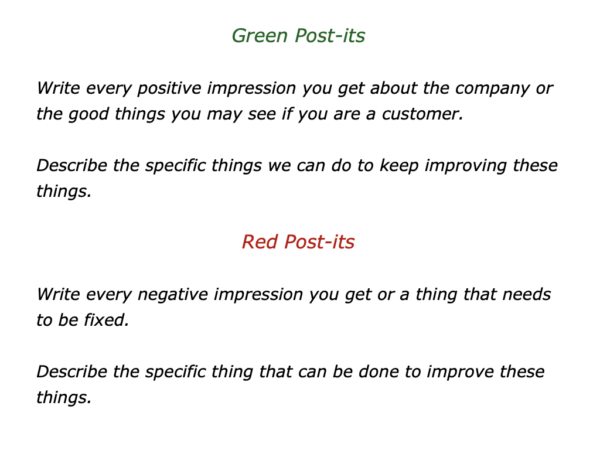
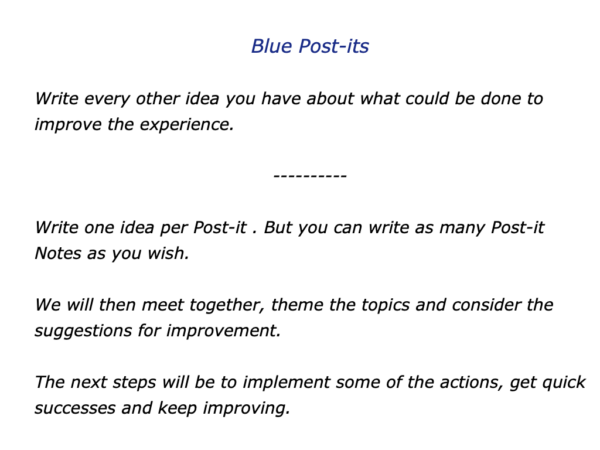
Karen and the staff started out on the journey. This took approximately an hour and people made stacks of notes. They then met together and agreed on the ways forward.
As could be predicted, Karen saw many more things than some of the staff. She later presented these in a positive way, however, and it helped to open people’s eyes to seeing things in a different way.
The exercise was repeated with all the staff and led by other managers rather than Karen. This led to many more people becoming obsessed by quality and improving the stores.
Let’s return to your life and work. If you wish, try tackling the exercise on these theme.
First, describe a specific thing that you may be obsessed by. Second, describe the potential pluses and minuses of this obsession. Third, describe how you can build on the pluses and manage any minuses when following this obsession.
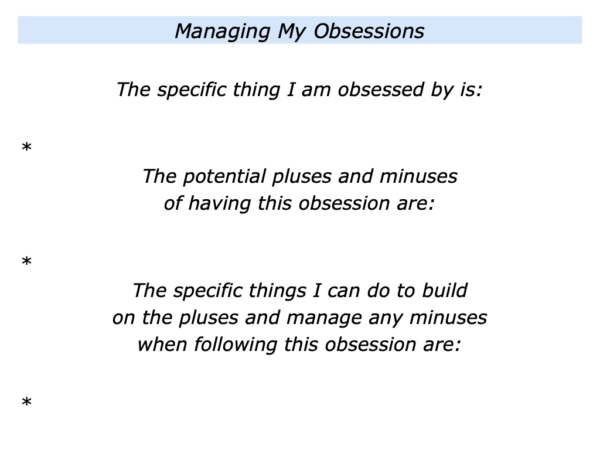
Being Obsessed With Quality






Leave a Reply